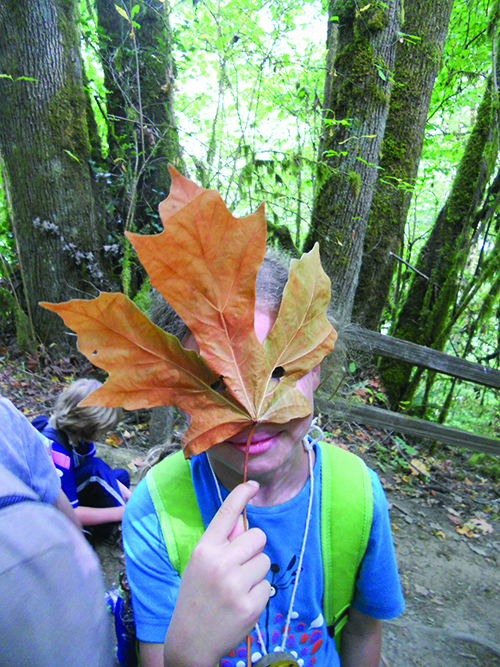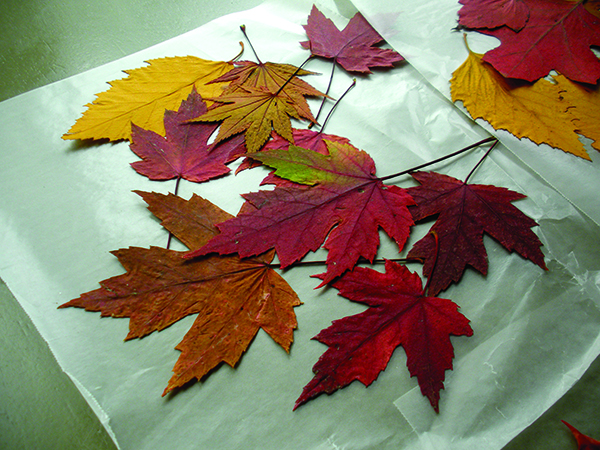

Article and photographs by Katie Boehnlein
Title photograph by Andrea Hungerford
After a warm summer, it is hard to believe that fall is upon us. Deep in our lush urban forests, Bigleaf Maple trees quietly release yellowing leaves, Banana Slugs hope for our rains to dampen dry soil, and Douglas Squirrels hoard their caches for the wet months ahead. Fall is my favorite season, alive with the bounty of the harvest. Unfortunately, fall is as fleeting as it as beautiful. Before we know it, our favorite trees will have dropped all their leaves, saving their energy for the warmer days of spring. Below you will find ideas for artists of all ages to preserve fall foliage well into the bare wetness of winter. If your family is interested in natural history, I have also supplied brief botanical information about native trees and shrubs to help you identify your collections. Happy Hunting!
FORAGING FOR LEAVES
It’s time to get some leaves! Pull on those rain boots and slickers, bring a tote bag for collecting, and to respect wildlife don’t forget to practice your quietest trail walking. Venture into the urban wildlands that surround you: Forest Park, Oaks Bottom, Mt. Tabor, Camassia Natural Area, Pier Park, keeping your eyes open for fall color. Pick up only the leaves that you think you will use at home; the rest are needed to feed woodland decomposers such as slugs, snails, beetles, and worms who transform leaves into rich forest soil in the winter.
LET FALL INSPIRE YOU
Once you return from your adventure(s), your leaf collection can be preserved in a variety of ways. Here are some ideas to get you going:
- Preserve leaves between pages of waxed paper. Gently melt the pages together by lightly ironing them. You will be left with a beautiful stained-glass-like leaf to hang in the window or use as a centerpiece on the dinner table. If you have younger children or you don’t want to risk the heat of the iron, sticky contact paper works just as well.
- Take classic crayon leaf-rubbings to the next level by experimenting with many mediums! Place a piece of paper over your leaf of choice and reveal its unique texture by gently rubbing it with crayons, oil pastels, pencils, or even charcoal. You can even experiment with the type of paper you use: tissue paper, brown paper bags, and colored paper all make beautiful canvases for your creations.

- Use leaves as stamps. One of the most beautiful (and messiest!) use of leaves is to use them as stamps or stencils. To use a leaf as a stamp, place your paper of choice on a sturdy table covered in newspaper. Place the leaf next to your blank paper and cover its surface with a thin layer of paint or ink (watercolor, acrylic paint, printing ink, or a stamp pad applied to surface). Using a pair of tweezers, gently pick up the stem of your leaf, turning it over onto the blank paper. Using a piece of scratch paper, cover the backside of the leaf and gently apply pressure, ensuring that the leaf ’s shape is permanently inscribed on your paper. Remove the scrap paper and the leaf with the tweezers, being careful not to smear your image. You will be left with a beautiful leaf print! You can reverse this process by using a leaf as a stencil. Place your leaf on the paper first, using paint or ink to color the area outside the leaf instead. Gently remove the leaf from your paper with tweezers to leave the leaf ’s blank outline on the page!
- If you bring home green leaves, you can capture the plant’s natural ink. Arrange the green leaves in a design on a piece of blank paper and then cover the design with a piece of scratch paper. With a hammer or other flat-ended tool, gently tap the piece of scratch paper until you think the leaves have adequately released their paint. Remove the scratch paper and leaves- voilá!
- There are many uses for your creative experiments! Use your leaf images as holiday cards and stationery, as giftwrap, or simply frame them for memories of fall all year round!
KNOW YOUR TREES!
The Portland area is characterized by lush, moss-strewn temperate rainforests. I have listed four broadleaf trees here, or trees that lose their leaves in the winter. Other trees and shrubs are conifers (producing cones) or those that stay green all year round (evergreen). The books mentioned below will serve as further reading and help with identification.
- Bigleaf Maple (Acer macrophyllum) trees are characterized by moss-covered bark and unusually large leaves. The leaves can grow to be 12 inches across! In autumn, leaves from this tree turn a beautiful golden yellow color, blotched with green or brown.
- Vine Maples (Acer circinatum) are technically a shrub and not a tree, but these plants can grow to be quite large, typically 10-15 feet tall with brilliant red leaves in the autumn. You will recognize a Vine Maple by it nine-lobed leaf, spelling out its name (v-i-n-e-m-a-p-l-e)! Native Americans used its flexible boughs to create sturdy baskets and snowshoes.
- Red Alder (Alnus rubra) is often found near rivers and other riparian habitats. Its leaves are oval-shaped, with deep, prominent veins rising diagonally from a center line. I often identify red alder trees by the miniature woody “cones” that they drop onto the ground.
- Black Cottonwood (Populus trichocarpa) trees are found near prominent water sources. Oaks Bottom Wildlife Refuge along the Willamette River, for instance, is almost entirely made up of Cottonwood trees. Cottonwoods are easily identified by their heart-shaped leaves and (in the warmer months), seeds encased within wispy, cotton-like fluff that easily float in the wind.
- Sword Ferns (Polystichum munitum) are neither trees nor shrubs but are one of the most common plants in the Pacific Northwest and fun to use in art projects. Sword ferns are the hardiest of all ferns and darkest in color. If you are unsure about identifying a sword fern, look at each individual leaflet growing on the stem. Does it resemble a sword encased in a sheath?
Katie Boehnlein is a teacher and writer living in Oregon where you can find her exploring the beautiful natural areas of Portland and Ashland on foot and by bike. She grew up traversing the trails and staircases of Southwest Portland, which began a life-long passion for urban wildlife and adventure. Katie blogs about her nature adventures and travel at “In the Midst” at kboehnlein.wordpress.com.


